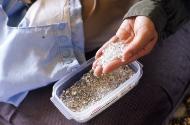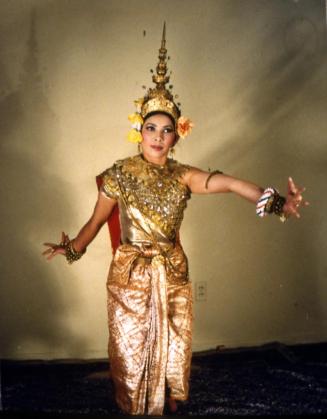Sophanna Keth Yos and Sotha Keth
SubjectPortrait of
Sophanna Keth
(Cambodian)
SubjectPortrait of
Sotha Keth
(Cambodian)
SubjectPortrait of
Somaly Hay
(Cambodian, 1959 - 2016)
SubjectPortrait of
Sokphury Yos
PhotographerPhotographed by
Gale Zucker
Date1994
MediumPhotography; color slides on plastic in cardboard mount
ClassificationsGraphics
Credit LineConnecticut Cultural Heritage Arts Program collections
CopyrightCopyright Held By Gale Zucker
Object number2015.196.146.1-.16
DescriptionSlides of Sophanna Keth Yos and Sotha Keth taken as part of the Living Legends exhibition project. Slides were taken by Gale Zucker except (.14), which was taken by Phillip Fortune.
(.1) Sophanna Keth working on a costume while her daughter, Sokphury Yos, watches to learn the process.
(.2) Sophanna Keth threading beads onto a needle while Sokphury observes.
(.3) Sophanna Keth beading. Somaly Hay's green and gold Male Role costume is in the background.
(.4) Sophanna Keth seated on a cushion while sewing a costume with a view from above of costume pieces. Sokphury watches.
(.5) A white and gold costume for Apsara Role, along with a box of gold beads to be sewn on.
(.6) A view of Sophanna Keth's hands attaching embellishment to the costume's fabric.
(.7) Sophanna Keth seated a on cushion. A sewing machine and the costume for the Male Role are in the background.
(.8) A white and gold costume for the Apsara Role, with beads and gold decoration to add.
(.9) Sotha Keth standing behind Sokphury wearing a gold crown he has made.
(.10) Sotha Keth standing behind Sokphury, who is trying on the crown he has made. She wears the white and gold Apsara costume as she is going to dance that role.
(.11) A hand holding white costume beads.
(.12) Sotha Keth looking at a crown.
(.13) Sophanna Keth sewing beads and sequins while surrounded by materials. Sokphury is in the background.
(.14) Gold jewelry. Photo by Phillip Fortune.
(.15) Slide of a photograph of Somaly Hay dancing. The photo inscription reads: “State council on the arts.” This image was sent with her application for a fellowship in 1999.
(.16) Close up view of a crown exhibited in the Living legends exhibit. The inscription reads, “Cambodian crown.”
NotesBiographical Note: Brother and sister, Sotha Keth and Sophanna Keth Yos, lived in the New London area near their sister Somaly Hay, a classical Cambodian dancer. The family members who survived the Khmer Rouge genocide, which destroyed so much of Cambodia and its culture from 1974-1979, fled to the United States in 1981, and Sophanna followed in 1987. In presenting and teaching Cambodian dance, Sotha, Somaly, Sophanna, and their extended family of friends, colleagues, and relatives were dedicated to helping young Cambodian people retain a sense of Cambodian cultural values through knowledge of their traditions.(.1) Sophanna Keth working on a costume while her daughter, Sokphury Yos, watches to learn the process.
(.2) Sophanna Keth threading beads onto a needle while Sokphury observes.
(.3) Sophanna Keth beading. Somaly Hay's green and gold Male Role costume is in the background.
(.4) Sophanna Keth seated on a cushion while sewing a costume with a view from above of costume pieces. Sokphury watches.
(.5) A white and gold costume for Apsara Role, along with a box of gold beads to be sewn on.
(.6) A view of Sophanna Keth's hands attaching embellishment to the costume's fabric.
(.7) Sophanna Keth seated a on cushion. A sewing machine and the costume for the Male Role are in the background.
(.8) A white and gold costume for the Apsara Role, with beads and gold decoration to add.
(.9) Sotha Keth standing behind Sokphury wearing a gold crown he has made.
(.10) Sotha Keth standing behind Sokphury, who is trying on the crown he has made. She wears the white and gold Apsara costume as she is going to dance that role.
(.11) A hand holding white costume beads.
(.12) Sotha Keth looking at a crown.
(.13) Sophanna Keth sewing beads and sequins while surrounded by materials. Sokphury is in the background.
(.14) Gold jewelry. Photo by Phillip Fortune.
(.15) Slide of a photograph of Somaly Hay dancing. The photo inscription reads: “State council on the arts.” This image was sent with her application for a fellowship in 1999.
(.16) Close up view of a crown exhibited in the Living legends exhibit. The inscription reads, “Cambodian crown.”
One of the problems dancers like Somaly faced after moving here was finding traditional performance costumes. A highly specialized, elaborate art in itself, costume making depends on reproducing stylized clothing forms for the different roles of the classical dance repertoire. Contact with Cambodia was difficult at that time, making the proper materials, patterns, or examples of costume designs unavailable or prohibitively expensive. Sotha and Sophanna began the process of learning and then making the intricate costumes for Somaly, using materials that could be found in America. Sotha began to design the dance crowns relying on his memory, pictures of classical Cambodian art from library books, and an imaginative, experimental approach to using new materials. "I try to find materials, whatever we could find here in the U.S., to join together, glue, or make by hand, cut and chisel, to make the piece. Finally we did one, then turned to another one because there are so many different crowns needed." He constructed crowns in a variety of ways, refining his methods through trial and error over the years. Most were made of papier mache, painted and covered with copper or aluminum highlights. Sotha had to buy a lathe and learn woodworking, because wood is often the best material for a crown's tall embellishments. The paint must evoke the gold of original crowns, but finding the right shade was difficult. If he could afford it, Sotha would apply gold leaf. He traveled to as many of Somaly's performances as possible, to see how the crowns fit and wear. "I try to make the crowns as light as possible, because the performance takes a couple of hours plus the time it takes to put on the costumes...I want them to feel comfortable. If they feel nice the performance will be good also. If the crown is heavy...they will get sore and tired and the performance will not be good. Whatever the performer feels, that's what I feel too."
Like Sotha, Sophanna's memory of watching dancers at the palace helped her design traditional clothes. She also studied books, slides, and old films showing figures on temple carvings, because dance roles and costumes were often drawn from these beings. Sophanna sewed and embroidered the clothes, adding thousands of beads and sequins by hand to make the costume catch the light and look like gold and silver. Her work did not end there, as she needed to sew parts of the costume onto the dancer before the performance, and cut her out of it afterwards. Sophanna taught her daughter Sokphury how to sew the costumes, since Sokphury has learned to dance with Somaly. "Children came (to America) in the war, they come here very little and grow up here...they don't know their own culture! hey ask me, 'What is that worn for?' I say, 'That is your own culture - we wear this for classical dance.' They are interested! At least some youngsters get to know their culture...Some Cambodian ladies came (to a performance in Chicago) and they were so excited because they lost their culture for a long time and now they see it again."
Subject Note: "Living Legends: Connecticut Master Traditional Artists" was a multi-year project to showcase the excellence and diversity of folk artists living and practicing traditional arts throughout the state. The first CCHAP Director, Rebecca Joseph, developed the first exhibition in 1991, displaying photographic portraits along with art works, and performances representing fifteen artists from different communities, at the Institute for Community Gallery at 999 Asylum Avenue in Hartford. In 1993, the next CCHAP Director, Lynne Williamson, organized two exhibitions of the photographic portraits from the original Living Legends exhibit, at the State Legislative Offices and at Capital Community-Technical College in Hartford. The photographs were also displayed in the Capitol Rotunda in Washington, DC in October 1994, with the help of Connecticut Representative Nancy Johnson. Also in 1993, a grant from NEA Folk Arts was awarded to CCHAP to expand and tour the original exhibit and create a video to accompany it. The Connecticut Humanities Council and the Connecticut Commission on the Arts supported an exhibit catalogue and a performance series. CCHAP began fieldwork around the state in 1994 to document several of the artists involved in the first exhibit and add new artists. The expanded version of Living Legends opened at ICR's Gallery at its new office space at 2 Hartford Square West, then traveled to several sites in 1994 and 1995, including the Norwich Arts Council, the Torrington Historical Society, and the New England Folklife Center, Boott Mills Museum at Lowell National Historical Park in Lowell Massachusetts. CCHAP along with folklorist David Shuldiner produced a video based on images taken of the artists at work and audio interviews conducted with them. Portraits and images of the artists working were taken by photographer Gale Zucker. A catalogue of the images, art works, and texts based on the artist interviews was compiled by CCHAP and designed by Dan Mayer who also served as the exhibition designer.
Thirteen visual artists were included in the second Living Legends project: Eldrid Arntzen, Norwegian rosemaling; Qianshen Bai, Chinese seal carving; Katrina Benneck, German scherenschnitt; Alice Brend, Pequot ash basket making; Romulo Chanduvi, Peruvian wood carving; Laura Hudson, African-American quilt making; Ilias Kementzides, Pontian Greek lyra making and playing; Sotha Keth and Sophanna Keth Yos, Cambodian dance costume making; Keith Mueller, decoy carving; Bernabela Quinones, Puerto Rican mundillo lace; Walter Scadden, decorative ironwork; Nucu Stan, Romanian straw pictures. Five performing artists were presented during the first Living Legends project: Sonal Vora, Indian Odissi dance; Somaly Hay, Cambodian court dance; Ilias Kementzides, Pontian Greek lyra; Abraham Adzenyah, Ghanaian music and drumming; and La Primera Orquesta de Cuatros, Puerto Rican cuatro group.
Additional audio, video, and/or photographic materials exist in the archive relating to these artists.
Cataloging Note: This project was made possible in part by the Institute of Museum and Library Services MA-245929-OMS-20.
Status
Not on view


























